Gardening is a rewarding and fulfilling hobby that allows you to cultivate your own green oasis right at home. Whether you have a spacious backyard or limited space in an apartment, there are gardening techniques that anyone can master to create a thriving garden. In this comprehensive guide, I will share valuable tips and strategies for successful home gardening, covering everything from plant selection to pest management and sustainable practices.
Key Takeaways:
- Choose the right plants for your garden based on factors like climate and soil conditions.
- Prepare the soil properly by removing weeds, adding organic matter, and ensuring good drainage.
- Water and fertilize your garden regularly, using eco-friendly and organic methods whenever possible.
- Utilize urban and indoor gardening techniques to overcome space limitations and grow plants in small areas.
- Explore the art of container gardening for a versatile and sustainable approach to growing plants.
With these key takeaways in mind, you’ll be well-equipped to start your gardening journey and create a thriving and beautiful garden right at home. Stay tuned for the following sections, where we’ll delve into more detailed tips and techniques for each aspect of home gardening. Happy gardening!
Getting Started: Choosing the Right Plants and Preparing the Soil
Before diving into the world of gardening, it’s important to choose the right plants for your specific location and prepare the soil accordingly. This will ensure that your plants thrive and grow to their full potential. Whether you’re a beginner or an experienced gardener, these gardening hacks and DIY methods will help you get started on the right foot.
When selecting plants for your garden, consider the climate and growing conditions in your area. Some plants are more suitable for hot and sunny climates, while others thrive in cool and shady environments. It’s essential to choose plants that are well-suited to your local climate to increase their chances of survival and success.
Once you’ve chosen the right plants, it’s time to prepare the soil. Good soil is the foundation for healthy plants and abundant harvests. Start by removing any weeds or debris from the area where you plan to plant. Loosen the soil using a garden fork or tiller, breaking up any clumps and promoting better drainage. If the soil is compacted or lacks nutrients, consider adding organic matter such as compost or aged manure to improve its fertility.
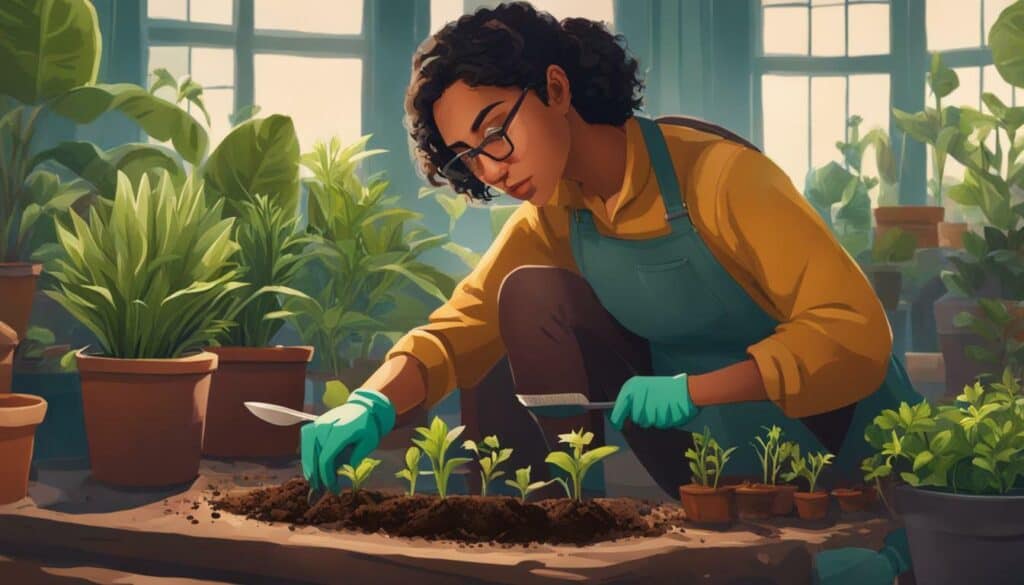
Remember to read the instructions on the plant tags or packaging for specific soil requirements. Some plants prefer acidic soil, while others thrive in alkaline conditions. Adjust the pH of your soil accordingly to create an optimal growing environment for your plants. Soil testing kits are readily available and can help you determine the pH level of your soil.
“Good soil is the foundation for healthy plants and abundant harvests.”
Choosing the Right Plants and Preparing the Soil: A Summary
- Choose plants that are well-suited to your local climate and growing conditions.
- Consider the specific soil requirements of your chosen plants and adjust the pH level accordingly.
- Remove weeds and debris from the planting area and loosen the soil to ensure proper drainage.
- Add organic matter such as compost or aged manure to improve soil fertility.
- Read the instructions on plant tags or packaging for specific soil preparation guidelines.
| Plant | Sunlight Requirements | Soil pH |
|---|---|---|
| Tomatoes | Full sun (6-8 hours) | Neutral to slightly acidic (6.0-7.0) |
| Roses | Full sun (6-8 hours) | Neutral to slightly acidic (6.0-7.0) |
| Lettuce | Partial shade (4-6 hours) | Neutral to slightly alkaline (6.0-7.0) |
Nurturing Your Garden: Watering, Fertilizing, and Maintenance Tips
Properly nurturing your garden through regular watering, fertilizing, and maintenance is key to achieving healthy and thriving plants. By following these backyard gardening strategies and organic gardening practices, you can create an environment that promotes optimal growth and yields beautiful results.
When it comes to watering your garden, it’s important to strike a balance. Overwatering can lead to root rot and other issues, while underwatering can cause plants to wither and die. The best approach is to water deeply and infrequently, allowing the soil to dry out between watering sessions. This encourages plants to develop strong root systems that can better withstand drought conditions.
In addition to proper watering, fertilizing your plants is crucial for providing them with the necessary nutrients for growth. Organic fertilizers, such as compost and well-rotted manure, are excellent choices as they enrich the soil without introducing harmful chemicals. Be sure to follow the recommended application rates to avoid overfertilization, which can harm plants.
Maintenance tasks play a vital role in keeping your garden healthy and vibrant. Regularly inspecting plants for signs of pests and diseases allows for early detection and prompt treatment. Pruning, deadheading, and removing weeds are also important maintenance practices that help improve overall plant health and appearance.
To summarize, maintaining a healthy garden involves a combination of proper watering, fertilizing, and routine maintenance. By implementing these backyard gardening strategies and organic gardening practices, you can create a thriving garden that brings you joy and satisfaction.
| Backyard Gardening Strategies | Organic Gardening Practices |
|---|---|
|
|
“The love of gardening is a seed once sown that never dies.” – Gertrude Jekyll
Avoiding Common Mistakes: Tips for Successful Gardening
While nurturing your garden, it’s important to avoid common mistakes that can hinder the growth and health of your plants. Here are a few tips to ensure successful gardening:
- Know your soil: Test the pH level and nutrient content of your soil to determine its suitability for different plants. Adjustments can be made by adding organic matter or amendments.
- Proper plant selection: Choose plants that are well-suited to your regional climate and conditions. Consider factors such as sun exposure, temperature, and soil type when selecting plants for your garden.
- Regular monitoring: Keep a close eye on your plants for any signs of stress, pests, or diseases. Early intervention can prevent widespread damage.
- Sustainable watering: Use rainwater collection systems or drip irrigation to minimize water waste and ensure efficient watering.
Remember, gardening is a process of learning and experimentation. Don’t be afraid to try new techniques and plants. With patience and dedication, your garden will flourish and provide you with endless joy and beauty.
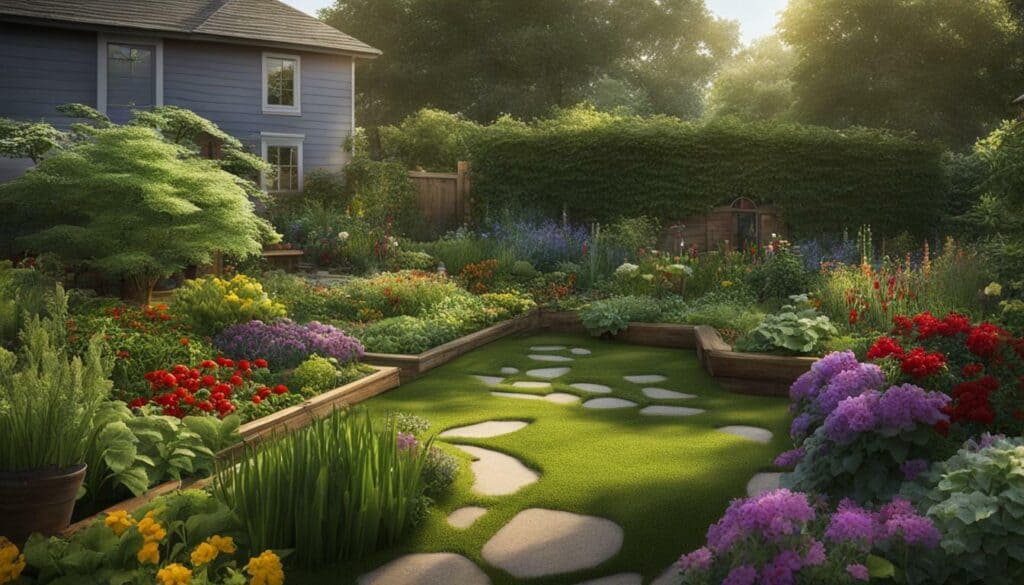
Maximizing Space: Urban and Indoor Gardening Techniques
Don’t let limited space deter you from enjoying the benefits of gardening – discover the art of urban and indoor gardening and transform even the smallest spaces into lush green havens. Whether you live in a bustling city apartment or have a compact space indoors, there are numerous techniques and ideas to help you create a thriving garden environment.
In urban gardening, vertical gardens are a popular choice to maximize space. By utilizing walls or hanging planters, you can cultivate a variety of plants without sacrificing precious floor space. Plants such as ivy, ferns, and succulents thrive in these setups and add natural beauty to any urban setting.
Indoor gardening provides an opportunity to bring nature into your home. From herb gardens on your kitchen windowsill to terrariums in your living room, there are endless possibilities for creating mini gardens indoors. Not only do indoor plants purify the air, but they also add a touch of tranquility and serenity to your living spaces.
To help get you started, here are a few urban and indoor gardening techniques:
- Create a living wall by attaching planters to a vertical surface, such as a fence or wall.
- Utilize hanging baskets or wall-mounted planters to save space and add visual interest.
- Choose compact plant varieties or those that can be pruned to maintain a smaller size.
- Experiment with different types of containers, such as repurposed items or self-watering pots.
- Provide adequate lighting for indoor plants by placing them near windows or using artificial grow lights.
- Ensure proper drainage for potted plants by using saucers or adding drainage holes to containers.
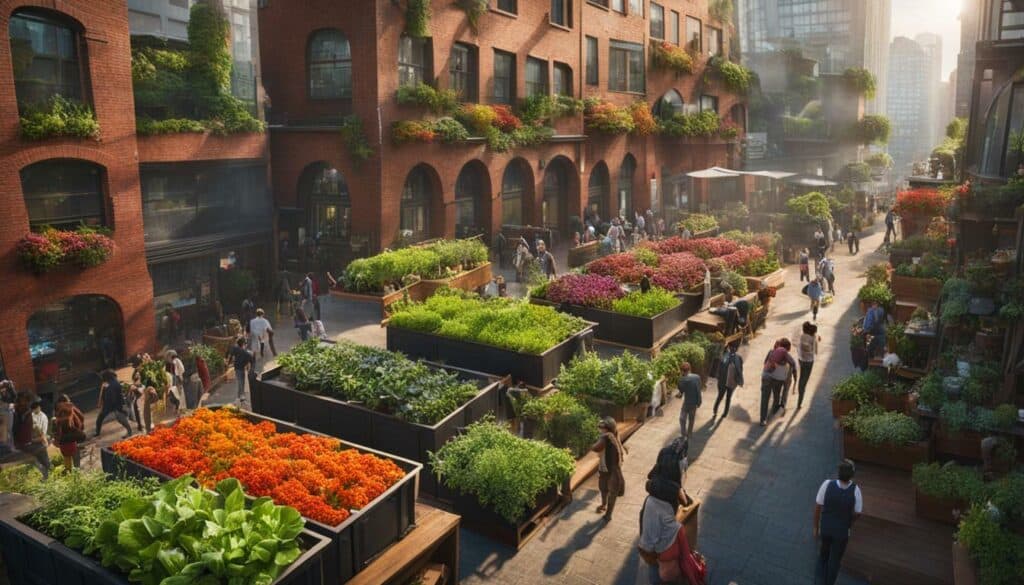
Remember, urban and indoor gardening is not just about the plants – it’s also a way to express your creativity and personal style. Embrace the opportunity to transform your living spaces into green oases that not only provide a breath of fresh air but also contribute to a healthier, more sustainable lifestyle.
Container Gardening: Tips for Growing Plants in Containers
Container gardening offers a flexible and sustainable way to cultivate plants, allowing you to enjoy the beauty of nature even in limited spaces. Whether you have a small balcony, a rooftop terrace, or a tiny backyard, containers can be used to bring life and color to your surroundings. Not only do they offer versatility in terms of placement and design, but they also provide effective solutions for those who want to grow plants without the need for large garden beds.
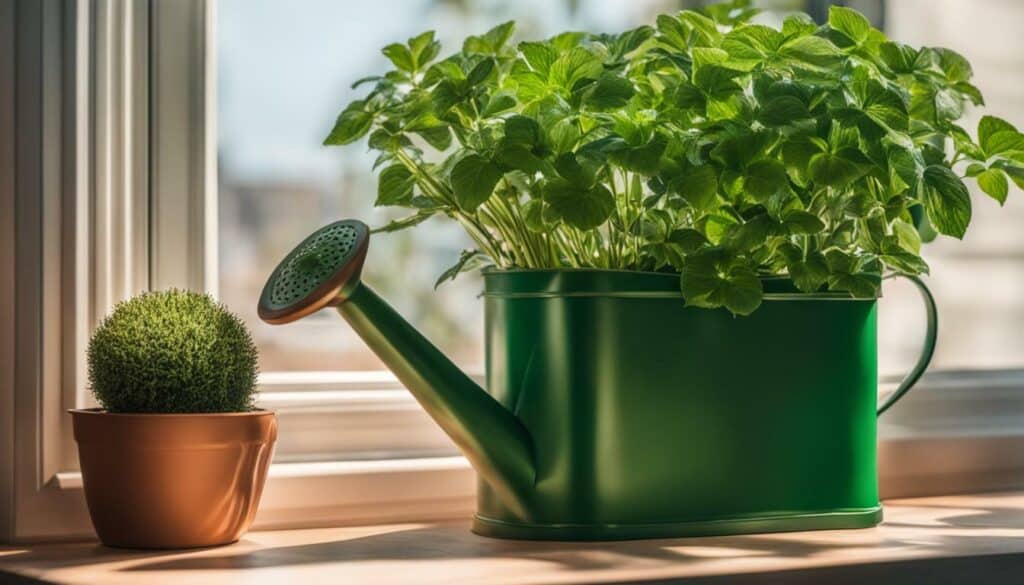
In container gardening, selecting the right containers is essential. Consider the size and material of the containers, ensuring they have proper drainage holes to prevent waterlogging. Additionally, choose containers that are suitable for the plants you wish to grow. For example, herbs and small vegetables can thrive in smaller pots, while larger plants like tomatoes and peppers require larger containers.
“When planting in containers, it’s important to select the appropriate potting mix,” advises gardening expert Jane Green. “Look for a lightweight, well-draining mix that contains organic matter. This will provide the right balance of air and moisture for healthy root development.”
| Container Gardening Tips | Sustainable Gardening Methods |
|---|---|
|
|
By implementing sustainable gardening methods, such as using recycled materials as planters and practicing companion planting, you can nurture a thriving container garden while minimizing your environmental impact. Remember to position your containers in areas with adequate sunlight for your plants’ needs and provide regular watering and fertilization to promote healthy growth.
A Year-Round Guide: Gardening Calendars and Seasonal Tasks
A well-planned gardening calendar is essential for staying on top of seasonal tasks and ensuring a thriving garden all year round. By following a month-by-month guide, you can stay organized and make the most of each season. Here is a breakdown of gardening tasks and activities to consider throughout the year:
Spring
- Start seeds indoors for summer vegetables, herbs, and flowers.
- Prepare garden beds by removing weeds, loosening the soil, and adding compost.
- Plant cool-season crops like lettuce, spinach, and peas.
- Prune fruit trees before they start to bud.
Summer
- Water your garden regularly, especially during dry periods.
- Harvest ripe fruits and vegetables regularly to encourage continuous production.
- Pinch back herbs to encourage bushier growth.
- Protect plants from extreme heat by using shade cloth or mulching.
Fall
- Plant cool-season crops like broccoli, cabbage, and carrots.
- Clean up the garden by removing spent plants and debris.
- Prepare garden beds for the winter by adding compost or mulch.
- Plant spring-flowering bulbs like tulips and daffodils.
Winter
- Protect tender plants from frost by covering them or moving them indoors.
- Monitor and adjust watering to prevent waterlogging or dehydration.
- Plan your garden for the upcoming year by researching new plants and garden designs.
- Prune dormant trees and shrubs to maintain their shape and health.
A well-maintained garden requires consistent effort throughout the year. By following a gardening calendar, you can stay organized and make the most of each season. Remember to adjust the tasks based on your specific climate and growing conditions. Happy gardening!

Mastering Plant Health: Disease and Pest Management
Protecting your plants from diseases and pests is crucial for maintaining a flourishing garden. By implementing effective plant health management techniques, you can ensure the well-being and longevity of your beloved plants. Here are some essential tips to help you prevent and manage plant diseases and pests.
Identify the Signs
Being able to recognize the signs of plant diseases and pests is the first step towards effective management. Keep an eye out for wilting, discoloration, unusual growth patterns, or the presence of insects. Early detection can prevent the spread of diseases and minimize damage caused by pests.
Implement Natural Remedies
When it comes to plant health management, it’s best to opt for natural remedies whenever possible. Chemical pesticides can be harmful to the environment and beneficial insects. Instead, consider using organic solutions such as neem oil, insecticidal soap, or companion planting to deter pests and control diseases.
Remember, prevention is better than cure. Regularly inspect your plants, practice good sanitation, and maintain a healthy garden ecosystem to minimize the risk of diseases and pests.
Practice Integrated Pest Management
Integrated Pest Management (IPM) is a holistic approach that combines multiple strategies to control pests and diseases effectively. This method includes cultural, biological, and physical techniques, as well as the limited and careful use of pesticides when necessary. By implementing IPM, you can manage plant health while minimizing negative impacts on the environment.
Conclusion
Effective disease and pest management is essential for maintaining the health and vitality of your garden. By being proactive, identifying early signs, and implementing natural remedies and integrated pest management techniques, you can create a thriving garden that is resilient to diseases and pests.
Remember, prevention is key, and a healthy garden ecosystem is the best defense against plant health issues. Stay diligent, stay informed, and enjoy the rewards of a flourishing garden.
| Disease | Symptoms | Prevention | Treatment |
|---|---|---|---|
| Black Spot | Black spots on leaves, defoliation | Prune infected leaves, improve air circulation | Apply fungicides, remove infected leaves |
| Aphids | Stunted growth, distorted leaves, sticky residue | Encourage beneficial insects, use insecticidal soap | Apply neem oil, use strong blasts of water |
| Powdery Mildew | White powdery patches on leaves | Improve air circulation, avoid overhead watering | Apply sulfur or potassium bicarbonate-based fungicides |
The Beauty of Flowers: Growing and Caring for Ornamental Plants
Bring vibrancy and allure to your garden by exploring the diverse range of ornamental plants and discovering how to grow and care for beautiful flowers. Whether you have a large backyard or a small balcony, incorporating ornamental plants into your gardening repertoire can enhance the aesthetics of your outdoor space and create a soothing and visually pleasing environment.
When it comes to growing flowers, there is an abundance of options to choose from. From delicate roses to vibrant sunflowers, each flower species brings its own charm and character to your garden. Some popular types of plants that you can consider for your garden include hydrangeas, dahlias, and geraniums. These flowers come in various colors and sizes, allowing you to create stunning floral displays that are sure to be eye-catching.
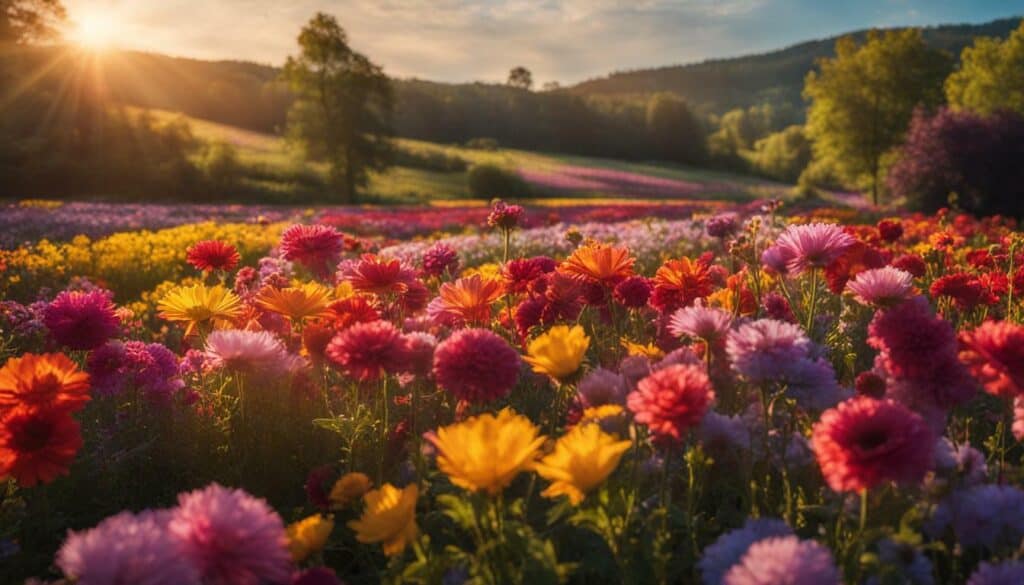
Proper care is essential for the health and longevity of ornamental plants. This includes providing sufficient sunlight, watering regularly, and using suitable fertilizers. It is also important to monitor for any pests or diseases that may affect the plants and take appropriate measures to prevent or manage them.
“The earth laughs in flowers.” – Ralph Waldo Emerson
As you embark on your journey of growing and caring for ornamental plants, remember that patience and persistence are key. Gardening is a continuous learning process, and each season brings new opportunities for growth and development. So get your hands dirty, experiment with different plant combinations, and let the beauty of flowers transform your garden into a delightful oasis that you can enjoy all year round.
Additional Resources:
- University of Maryland Extension: Ornamental Plants
- Gardening Know How: Starting a Garden
- Rodale’s Organic Life: Organic Gardening Tips
| Plant | Sunlight Requirements | Watering Needs | Blooming Season |
|---|---|---|---|
| Rose | Full sun | Regular watering | Spring to fall |
| Hydrangea | Partial shade | Moist soil | Summer to fall |
| Dahlia | Full sun | Regular watering | Summer to fall |
| Geranium | Full sun to partial shade | Moderate watering | Spring to fall |
A Greener Approach: Sustainable and Ecological Gardening Practices
As stewards of the Earth, embracing sustainable and ecological gardening practices is vital for creating a greener, more harmonious world. By implementing these practices, we can not only nurture our own gardens but also contribute to the preservation of our planet’s biodiversity and natural resources.
One of the key aspects of sustainable gardening is ecological design. This approach involves creating landscapes that work in harmony with nature, promoting the health of ecosystems and supporting local biodiversity. By incorporating native plants, creating habitats for beneficial insects and animals, and using organic fertilizers and pest control methods, we can create a more resilient and sustainable garden environment.
Sustainable gardening also encompasses responsible water management. Conserving water is crucial, especially in regions prone to drought. By implementing water-saving techniques such as installing rain barrels, using drip irrigation systems, and mulching to reduce evaporation, we can minimize water waste and ensure that our gardens thrive while preserving this precious resource.
| Key Principles of Sustainable Gardening | Benefits |
|---|---|
| Use of native plants | Promotes biodiversity and supports local ecosystems. |
| Composting and recycling | Reduces waste and enriches the soil with organic matter. |
| Pest and disease management | Minimizes the use of harmful chemicals and supports natural pest control methods. |
| Conservation of water resources | Preserves water and promotes sustainable water management. |
Sustainable gardening is not only beneficial for the environment but also for our own well-being. Spending time outdoors, surrounded by greenery and fresh air, has been scientifically proven to reduce stress and improve mental health. Additionally, growing our own organic fruits, vegetables, and herbs allows us to enjoy fresh, nutritious produce while reducing our reliance on store-bought, industrially farmed products.
Embracing sustainable and ecological gardening practices is a rewarding journey that not only beautifies our surroundings but also contributes to the greater good. By implementing these principles, we can create thriving gardens that are not only aesthetically pleasing but also environmentally responsible, making a positive impact on both our immediate surroundings and the planet as a whole.
Image

Conclusion
Gardening is a journey of patience, knowledge, and love, and by applying the techniques and tips shared in this comprehensive guide, you’ll be well on your way to becoming a master gardener in the comfort of your own home.
Throughout this guide, we have covered a wide range of topics to help you succeed in your gardening endeavors. From selecting the right plants and preparing the soil to nurturing your garden, maximizing space, and practicing sustainable gardening methods, each section offers valuable insights and practical advice.
By following month-by-month gardening calendars, you can stay on track with seasonal tasks and extend the growing seasons to maximize the productivity of your garden. Additionally, we have provided tips for preventing and managing plant diseases and pests, as well as guidance on growing ornamental plants and creating stunning floral displays.
Remember, gardening is not just a hobby, it’s a lifestyle that connects you with nature and brings joy to your life. So grab your gardening gloves, dig in the dirt, and watch your garden flourish with the knowledge and skills you’ve acquired. Happy gardening!
What Are Some Essential Planting and Gardening Techniques I Can Learn at Home?
Looking to improve your gardening skills at home? A comprehensive planting and gardening success guide can be a great resource. It will help you learn essential techniques such as soil preparation, seed selection, proper watering, and pest management. With this guide, you’ll be well-equipped to create a thriving garden right in your own backyard.
FAQ
Q: What is the importance of cold hardiness in gardening?
A: Cold hardiness is crucial in certain climates as it determines which plants can survive freezing temperatures. It affects plant selection and ensures the plants can withstand winter conditions.
Q: How can I winterize my garden?
A: To winterize your garden, you can cover plants with protective materials like burlap or tarps. This helps shield them from harsh winter elements and prevents damage.
Q: What maintenance tasks should I perform on apple trees during winter?
A: During winter, it’s important to prune apple trees, remove dead branches, and apply dormant sprays to prevent diseases and pests. These tasks help maintain tree health.
Q: What are the benefits of no-till gardening?
A: No-till gardening promotes healthier soil and plant growth as it minimizes soil disturbance, reduces erosion, and improves soil structure and fertility.
Q: How should I fertilize my plants?
A: Fertilization should be based on the specific needs of your plants. Conduct a soil test to determine nutrient deficiencies and choose fertilizers accordingly.
Q: What are the benefits of ecological design in urban landscapes?
A: Ecological design in urban landscapes improves biodiversity, reduces water usage, enhances air quality, and provides habitat for wildlife. It creates healthier and more sustainable urban environments.
Q: What types of plants are suitable for gardens?
A: There are various types of plants suitable for gardens, such as hydrangeas and dahlias. These plants offer beautiful flowers and can thrive in garden environments.
Q: Are there gardening tasks specific to each month?
A: Yes, gardening calendars provide month-by-month tasks to guide your gardening activities. These calendars ensure you stay on track and optimize your garden’s productivity throughout the year.
Q: What do I need to consider when starting a garden?
A: When starting a garden, consider factors such as choosing appropriate plants for your climate, preparing the soil correctly, and implementing effective pest management strategies.
Q: Are there resources available for becoming a Master Gardener?
A: Yes, there are resources and training programs available for individuals interested in becoming Master Gardeners. These programs provide knowledge, certification, and a community of fellow gardeners to connect with.
Q: What guides are available for planting and growing different types of plants?
A: There are various guides available, such as companion planting, extending growing seasons, and growing vegetables, herbs, and flowers. These guides offer valuable information and techniques for successful plant growth.
Q: How can I prevent and manage plant diseases and pests?
A: To prevent and manage plant diseases and pests, practice proper sanitation, choose disease-resistant plants, and use organic pest control methods. Regular monitoring and early intervention are key.
Q: How do I care for houseplants?
A: Houseplants require appropriate light exposure, regular watering, and proper soil moisture. Additionally, managing insects and providing occasional fertilization are essential for their overall health.





Leave a Reply